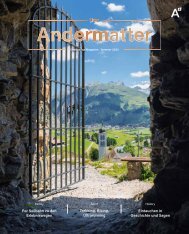Sie wollen auch ein ePaper? Erhöhen Sie die Reichweite Ihrer Titel.
YUMPU macht aus Druck-PDFs automatisch weboptimierte ePaper, die Google liebt.
In the dead of night, two peculiar figures make their way from Gurschenwald to Andermatt.<br />
They have long beards and robes. One is dressed entirely in brown, with a fierce face;<br />
the other’s features are framed by grey hair, a red cape and a large bishop's mitre. A little<br />
bell rings with every step and a lantern swings in time. Just a few steps behind follow<br />
five similar pairs – but with blue, green, yellow, purple and white cloaks.<br />
It is 6 December, shortly before 6 pm. Father Christmas, known in Switzerland as “Sami chlaus”,<br />
and his companion “Schmutzli” move through the entire village in solemn procession.<br />
The children in Andermatt wait with excitement. The traditional bell bearers – known as<br />
“Tryychler” – are all set to join the procession. And a few donkeys are waiting too, ready to<br />
play their part. The Andermatt people line the streets, awaiting the start of the<br />
annual spectacle with great expectation. The Santa Claus procession is a custom that<br />
involves everyone – the old and the young – ringing in the festive season.<br />
Nuts, gingerbread and chocolate<br />
This celebration in remembrance of St Nicholas has a long tradition in strongly Catholic<br />
regions. Until the start of the 19th century, however, it took a completely different form:<br />
in the “Klausjagen” or “Nicholas Chase”, it’s not Santa Claus and his companion Schmutzli<br />
who take to the streets, but a crowd of people in costumes, carrying loud instruments.<br />
This was much to the disapproval of the authorities, who felt the masquerade offended<br />
moral standards and repeatedly tried to impose a ban. In the end they were successful.<br />
In contrast to other parts of central and eastern Switzerland, the Nicholas Chases<br />
disappeared from Uri completely. The tradition in its current form took root from around<br />
1900, with the main focus shifting to giving gifts to the children. So Santa Claus and<br />
Schmutzli now visit the families in the village after their solemn procession, praising the<br />
little ones for their good deeds – and chiding them for any bad behaviour. Then there<br />
is a little sack of nuts, gingerbread and chocolate for each child.<br />
The Santa Claus tradition is maintained in many places in Uri by associations committed<br />
to upholding the custom. In Andermatt, it falls to the St. Nikolaus Organisation with its<br />
12 members – six Santa Clauses and six Schmutzlis. A few weeks before the ceremonial<br />
procession they are busy in the village, collecting donations from all the homes and<br />
checking who would like a visit from Santa Claus and his fierce companions at the start<br />
of December.<br />
WER WAR <strong>DER</strong> HEILIGE NIKOLAUS?<br />
WHO WAS ST NICHOLAS?<br />
Gemäss Überlieferung wurde der heilige<br />
Nikolaus um das Jahr 270 als Kind wohlhabender<br />
Eltern in Griechenland geboren.<br />
In der ersten Hälfte des 4. Jahrhunderts<br />
wirkte er als Bischof von Myra in der<br />
heutigen Türkei. Zahlreiche Legenden<br />
ranken sich um ihn: So soll er unter anderem<br />
drei fahrende Studenten, die auf ihrer Reise<br />
von einem Wirt ermordet und in einem Fass<br />
eingepökelt wurden, wieder zum Leben<br />
erweckt haben. Dieses Wunder machte den<br />
Bischof zum Patron der Kinder und Schüler.<br />
An seinem Namens- und Gedenktag, am<br />
6. Dezember, werden die unterschiedlichsten<br />
Bräuche gepflegt. Sie alle haben in der Regel<br />
etwas mit Kindern, Bescherung und vielfach<br />
auch mit ein wenig Klamauk zu tun.<br />
According to tradition, St Nicholas was born in<br />
Greece in the year 270 as the child of wealthy<br />
parents. In the first half of the fourth century,<br />
he was Bishop of Myra in the region that is now<br />
part of Turkey. Numerous legends surround<br />
him. Among them is the story of three travelling<br />
students, murdered on a journey by an innkeeper,<br />
their bodies preserved in a pickling<br />
barrel: legend has it that he brought them back<br />
to life. This Bishop became the patron of<br />
children and students as a result of this miracle.<br />
A wide variety of traditions are commemorated<br />
on 6 December, his Saint's day and commemoration<br />
day. They are usually all related to children<br />
and giving presents – and often involve a<br />
little tomfoolery.<br />
Laut erklingen die «Triichlä». The traditional “Triichlä” bell bearers ring loudly.<br />
43

















